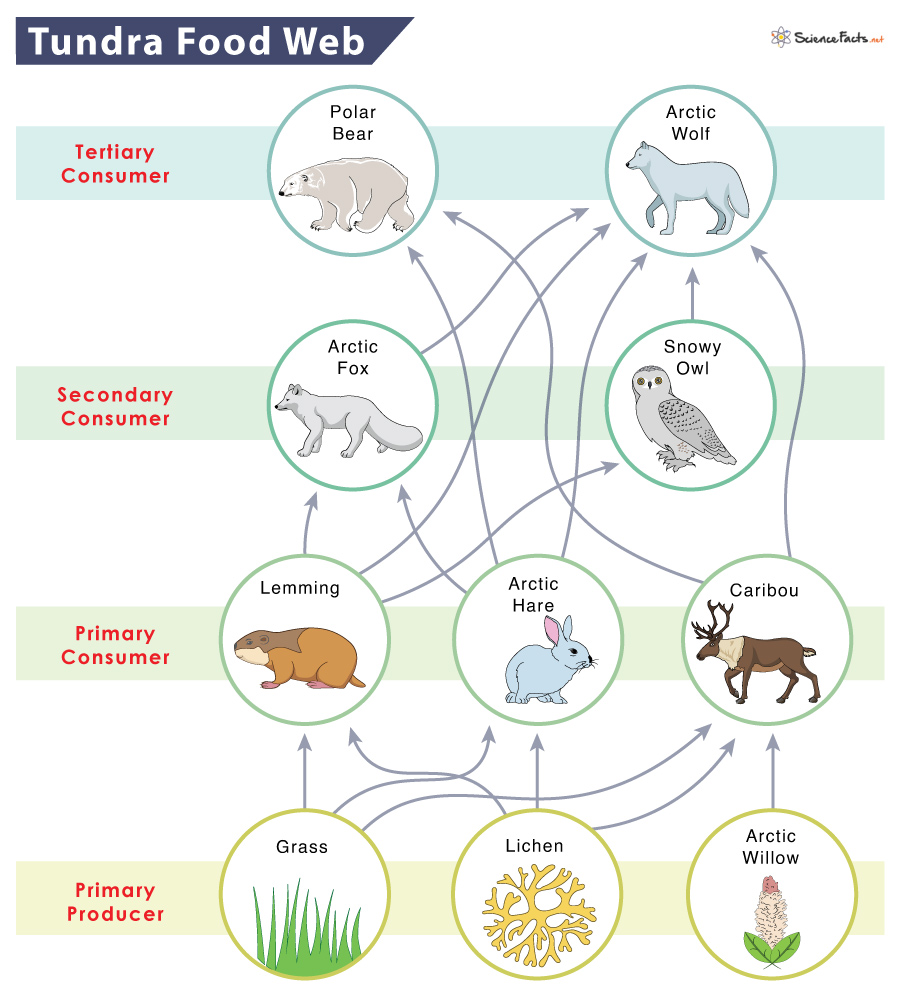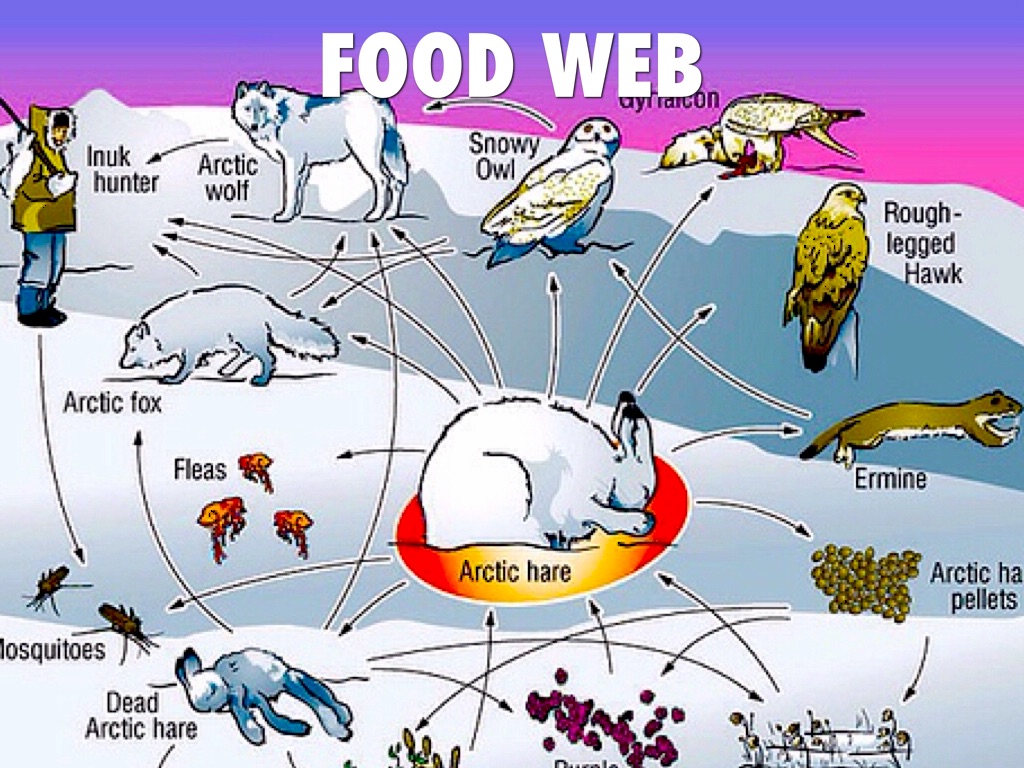Explore Tundra Food Webs: Energy Flow & Ecosystems - [Guide]
Does the stark beauty of the Arctic and Alpine tundras, seemingly barren landscapes, harbor a vibrant, interconnected world of life? The tundra, a biome characterized by its frigid temperatures, short growing seasons, and unique inhabitants, is a testament to nature's resilience and interconnectedness, showcasing how life thrives even in the most challenging environments.
The tundra biome, found in the far north and at high altitudes, is a realm of extremes. The long, harsh winters and short, cool summers dictate the rhythms of life, shaping the adaptations of the plants and animals that call this environment home. Understanding the intricacies of this ecosystem, including its food webs and the flow of energy, is crucial for appreciating its fragility and the impact of environmental changes. The study of tundra ecosystems offers vital lessons in adaptation and environmental balance. Across the globe, there are two primary types of tundra: arctic and alpine. The arctic tundra, as its name suggests, is found in the regions at the farthest northern points of the earth. Alpine tundra, often observed at high elevations, is characterized by colder temperatures, extended winters, and shorter growing seasons. The unique characteristics of the tundra biome shape a fragile ecosystem critical to our planet's health.
| Characteristic | Details |
|---|---|
| Definition | A biome characterized by extremely cold temperatures, a short growing season, and low amounts of annual rainfall. |
| Location | Primarily found in the Arctic Circle and at high elevations (alpine tundra). |
| Types | Arctic Tundra and Alpine Tundra. |
| Key Features | Treeless landscape, permafrost (permanently frozen ground), low biodiversity. |
| Examples |
|
| Ecological Significance | The tundra ecosystem provides many ecosystem services, including carbon storage, water cycling, and biodiversity. They also support a variety of human activities, including hunting, fishing, and tourism. |
The heart of the tundra ecosystem lies in its food webs, intricate networks that illustrate the flow of energy from one organism to another. A food web provides a fuller and more realistic picture of how energy moves through a biome, because it indicates multiple connections, overlaps and relationships. At the base of these webs are the producers: plants such as grasses, lichens, mosses, liverworts, algae, wildflowers, shrubs, sedges and grasses. These organisms, through the process of photosynthesis, harness the sun's energy to create their own food. In the arctic tundra, many types of producers, including flowering plants, low shrubs, sedges, grasses, mosses and algae, use the sun's energy during the process of photosynthesis. The tundra food web is no exception.
The primary consumers, or herbivores, such as caribou, hares, oxen and lemmings, depend on these producers for sustenance. These small rodents primarily consume grasses and sedges, but they are also known to feed on roots, bulbs, and lichens. Lemmings are a fundamental food source for many predators, making them an important link in the tundra food web. Their burrowing activities also aerate the soil, indirectly promoting plant growth and nutrient cycling. Following the herbivores are the secondary consumers: omnivores and carnivores such as foxes, bears, wolves, and whales. At the top of the food chain are the secondary consumers who consume the primary consumers. They are arctic wolves, snowy owls, and arctic foxes. When many food chains are linked together they create a food web. Most animals have many food sources and also have many predators. A food web shows these multiple pathways for energy to flow within an ecosystem. This helps give a more realistic view into whats really happening in nature.
In this intricate dance of life, energy flows from the producers to the consumers. Food chains, such as the one that may start with a producer like grass, and proceed with a primary consumer such as lemmings, then secondary consumer arctic fox, track this transfer of energy. In nature, it is eat and be eaten: All organisms, aside from plants and other producers, must eat organic matter for energy, and most organisms are eventually eaten by other organisms. A particular ecosystem can have a single food web with several food chains woven into it; the tundra food web is no exception. The example below shows the energy flow in a basic food chain in the tundra. This food chain is part of a more complex food web involving producers and consumers (herbivores, carnivores, and omnivores). Producers here include grasses, lichens, and caribou moss. Herbivores that eat these plants include the musk ox, arctic hare, and lemmings. Like other food chains, the different trophic levels of an arctic food chain are producers, primary consumers, secondary consumers, and apex predators. They include caribou, musk ox, arctic hares, ermines, lemmings, and harlequin ducks. After the carnivores hunt and eat their prey, they eventually get old and die. That's when decomposers that include lichen, mosses, and fungi decompose the carnivores back into soil to nurture future plants which grow and begin the cycle over again.
The structure of the energy or food pyramid in the tundra varies depending on its exact location. An example is the generalized terrestrial food pyramid of the arctic tundra. Terrestrial food webs are not the only types of food webs in the arctic. There are also marine food webs. The tundra biome, a world of stark beauty and quiet resilience, teaches us vital lessons about adaptation and environmental balance. In order to predict the effects of climate change on polar ecosystems, disentangling mechanisms of nutrient transfer in food webs is crucial. The top predators of the system tend to be mammalian carnivores, such as polar and brown bears, wolves and foxes, which eat a broad variety of prey.
The tundra experiences dramatic seasonal shifts, with summer abundance and winter scarcity significantly impacting food web dynamics. These changes drive migration, hibernation, and adaptations in both plants and animals, shaping species interactions throughout the year. These harsh conditions have led to remarkable adaptations in the tundra's inhabitants. Plants have evolved to grow quickly during the short summer season, often hugging the ground to stay warm and protected from the wind. Animals have developed thick fur, layers of fat, and behaviors like migration or hibernation to survive the frigid winters. Learn about the three types of tundras and the plants and animals that live there. Discover how the food chain and web work in each tundra and who are the apex predators. Tundra biome food web every ecosystem consists of plants, herbivores, and carnivores. Food chains identify who eats whom to demonstrate the flow of energy in a oneway, linear relationship.
Understanding the specific species that make up these food webs is crucial. For example, the arctic hare, and musk ox rely on producers. Their predators or eaters are the musk oxen, arctic wolves, snowy owls, and arctic foxes. Other examples include caribou, and lemmings, each playing a vital role in the energy flow. The arctic wolf is a key predator in the arctic tundra. The arctic bumble bee. Hay is an autotrophic plant and a producer its food chain. Pines are an autotrophic plant and are producers for animals in food chains.
Researchers have investigated sources of nutrients in tundra lakes. The food web is missing a main component in the transfer of energy. The tundra food webs are relatively simplistic compared to other biomes because biodiversity is low. Seasonal shifts in tundra food webs. Learn how energy flows in the tundra ecosystem, from producers to decomposers, through three types of food chains. See the adaptations and roles of plants and animals in the coldest biome on earth. These small rodents primarily consume grasses and sedges, but they are also known to feed on roots, bulbs, and lichens.
The arctic tundra is a region at the farthest northern point of the earth. A tundra is a biome that is very cold and dry, with sparse life. Despite the challenges of living there, several groups of organisms thrive in the tundra and these groups make up unique tundra food chains and webs. This chapter illustrates the interrelationships of tundra organisms through figure that represents a typical arctic tundra food web. In the arctic tundra, many types producers, including flowering plants, low shrubs, sedges, grasses, mosses and algae, use the sun's energy during the process of photosynthesis. When many food chains are linked together they create a food web. Most animals have many food sources and also have many predators. A food web shows these multiple pathways for energy to flow within an ecosystem. This helps give a more realistic view into whats really happening in nature. The tundra is a type of biome that is characterized by extremely cold temperatures, a short growing season, and low amounts of annual rainfall.
- Laura Ingrahams Marriage History Unveiling Her Relationships First Husband
- Ximena Saenz Nude Photos Videos Mustsee Content

Tundra Food Chain Examples and Diagram

Food Web Tundra Biome

Food Web The Tundra